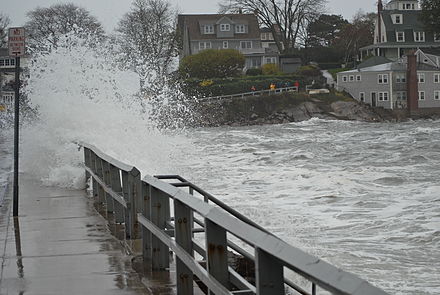Magical thinking in coastal flood zones
Damage in Westerly, R.I., from Hurricane Carol, which struck on Aug. 31, 1954.
Adapted from Robert Whitcomb’s “Digital Diary,’’ in GoLocal24.com
Consider the Federal Flood Insurance Program, which before Hurricane Florence arrived was $20 billion in debt. The program – the primary source of flood insurance in America -- is in need of deep reform.
The basic problem, besides the fact that Congress and the White House try to put as much stuff as possible on our collective credit card, rather than paying honestly with tax revenue: The federal government, to please affluent homeowners, especially along the seacoast, and campaign-contributor developers and real-estate agents, blithely subsidizes rebuilding in flood-prone areas – areas becoming ever more vulnerable because of the effects of global warming caused by fossil-fuel burning.
“They have not dealt with the gorilla in the room which is proactively addressing these types of disasters for the future,” Rob Moore, a senior policy analyst at the Natural Resources Defense Council, told Bloomberg News. “Too much of the U.S.’s response to natural disaster is completely reactionary: We throw a bunch of money after it happens.”
Indeed, after a hurricane slams a coastline, private and public rebuilding money pours into devastated areas, leading to the construction of more building in some places than were there before the hurricane!
Moore said that Congress should direct the Federal Emergency Management Agency, which runs the insurance program, to focus on strongly discouraging building in the areas most vulnerable to flooding as well as mandating that less exposed but still somewhat vulnerable structures be raised. The taxpayers have helped to rebuild some coastal-flood destroyed structures five or more times.
Last week it was the Carolinas, some late summer or early fall it will be southern New England when the eye of a northward-accelerating hurricane roars up the Connecticut Valley, exposing the coast of eastern Connecticut, all of Rhode Island and southeastern Massachusetts to a disastrous tidal surge. Most of us prefer not to help pay to rebuild a lot of McMansions on the dunes.
Regarding Florence, note that Orrin Pilkey, a retired Duke University coastal geologist, complained in a recent op-ed in the (Raleigh) News & Observer that the Tar Heel state hasn’t acted with the same rigor as, for example, the communities in Virginia and New Jersey, to prepare for rising sea levels.
'Streets full of water. Advise'
Flooding in Marblehead, Mass., on Oct. 29, 2012, during Hurricane Sandy.
From Robert Whitcomb's "Digital Diary,'' in GoLocal24.com
The population of flood-prone coastal zones in America is rising faster than elsewhere. That’s because most people love to live near water and developers have huge political and economic clout. Making matters worse is that the Feds’ National Flood Insurance Program does not take into account global-warming-connected sea-level rise, which is accelerating, especially along the U.S. East Coast. Just ask the people living in such low-lying places as Newport’s Point section; but at least that neighborhood of old houses will not be seeing more development.F
And the anti-environmentalist and very developer-friendly Trump administration wants to eliminate some rules in order to make development easier in flood-prone zones! U.S. taxpayers will get stuck with ever bigger bills to clean up the damage when these areas are hit by storms.
*Line reputedly in a telegram from Venice by the late humorist Robert Benchley.
To read a Governing Magazine article on this, please hit this link.


